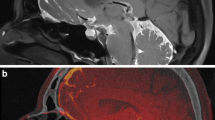Abstract
Background
In this study, we investigated the value of three-dimensional (3D) fast-imaging employing steady-state acquisition (FIESTA) magnetic resonance imaging (MRI) in detecting non-iatrogenic cerebrospinal fluid (CSF) rhinorrhoea and compared it with regular MRI and 3D magnetisation prepared rapid acquisition gradient echo (MPRAGE) MRI sequences, as well as high-resolution computed tomography (HRCT) imaging. We also present the endoscopic experiences of such cases.
Method
From June 2011 to Feb 2016, 17 patients with non-iatrogenic cerebrospinal fluid rhinorrhoea were included. Seven patients had spontaneous rhinorrhoea, three patients had invasive tumours, and the remaining patients had traumatic aetiologies. All the patients underwent HRCT, regular MRI sequence imaging, 3D-MPRAGE MRI sequence imaging and 3D-FIESTA MRI sequence imaging for the preoperative evaluations of the leakages. For each patient, the CSF fistula site was confirmed by intraoperative neuronavigation and endoscopic findings. Statistical analyses were performed. All patients underwent endoscopic multilayer repair.
Results
The sensitivities of the HRCT, regular MRI (T1 and T2), 3D-MPRAGE and 3D-FIESTA modalities for identifying CSF leakage were 58.8 %, (11.8 % and 29.4 %), 74.7 %, and 88.2 %, respectively. The origins of the leakages included the cribriform plate (18 %), ethmoidal fovea (23 %), lateral recess of the sphenoid (17 %), sellar floor (12 %), ethmoidal roof (12 %), junction of the fovea and cribriform plate (6 %) and the junction of sellar and sphenoidal planum (6 %). Two patients required repair. The first was under local anaesthesia when the nasal packing was removed, and the second underwent repair at the same site a half-year later due to hydrocephalus. Lumbar drainage was performed in all cases. No major complications were encountered.
Conclusions
The endoscopic endonasal approach is safe and effective for the treatment of CSF rhinorrhoea. The 3D-FIESTA MR modality is superior to 3D-MPRAGE MR and HRCT in the depiction of the CSF fistula site. Due to its non-invasive and reliable properties, 3D-FIESTA MR should be the preferred preoperative examination for the patients with non-iatrogenic CSF rhinorrhoea.



Similar content being viewed by others
References
Alonso RC, de la Peña MJ, Caicoya AG, Rodriguez MR, Moreno EA, de Vega Fernandez VM (2013) Spontaneous skull base meningoencephaloceles and cerebrospinal fluid fistulas. Radiographics 33(2):553–570
Friedman JA, Ebersold MJ, Quast LM (2001) Posttraumatic cerebrospinal fluid leakage. World J Surg 25:1062–1066
Zapalac JS, Marple BF, Schwade ND (2002) Skull base cerebrospinal fluid fistulas: a comprehensive diagnostic algorithm. Otolaryngol Head Neck Surg 126:669–676
Eftekhar B, Ghodsi M, Nejat F, Ketabchi E, Esmaeeli B (2004) Prophylactic administration of ceftriaxone for the prevention of meningitis after traumatic pneumocephalus: results of a clinical trial. J Neurosurg 101:757–761
Eljamel MS, Foy PM (1990) Acute traumatic CSF fistulae: the risk of intracranial infection. Br J Neurosurg 4:381–385
Oakley GM, Alt JA, Schlosser RJ, Harvey RJ, Orlandi RR (2016) Diagnosis of cerebrospinal fluid rhinorrhea: an evidencebased review with recommendations. Int Forum Allergy Rhinol 6:8–16
Hu F, Ye G, Zhang X, Xie T, Yu Y, Sun C, Li W (2014) Combined use of a gasket seal closure and a vascularized pedicle nasoseptal flap multilayered reconstruction technique for high-flow cerebrospinal fluid leaks after endonasal endoscopic skull base surgery. World Neurosurg 83(2):181–187
Eljamel MS, Pidgeon CN (1995) Localization of inactive cerebrospinal fluid fistulas. J Neurosurg 83:795–798
Sillers MJ, Morgan CE, Gammal T (1997) Magnetic resonance cisternography and thin coronal computerized tomography in the evaluation of cerebrospinal fluid rhinorrhea. Am J Rhinol 11:387–392
Wenz F, Hess T, Knopp MV (1994) 3D-MPRAGE evaluation of lesions in the posterior cranial fossa. Magn Reson Imaging 12(4):553–558
Wolfsberger S, Ba-Ssalamah A, Pinker K (2004) Application of 3 T magnetic resonance imaging for diagnosis and surgery of sellar lesions. Neurosurgery 100:278–286
Xie T, Xiao-Biao Z, Hong Y (2011) 3D-FIESTA MR images are useful in the evaluation of the endoscopic expanded endonasal approach for midline skull-base lesions. Acta Neurochir (Wein) 153(1):12–18
Algin O, Hakyemez B, Gokalp G, Ozcan T, Korfali E, Parlak M (2010) The contribution of 3D-CISS and contrast-enhanced MR cisternography in detecting cerebrospinal fluid leak in patients with rhinorrhea. Br J Radiol 83:225–232
Gammal TE, Sobol W, Wadlington VR (1998) Cerebrospinal fluid fistula: detection with MR cisternography. AJNR Am J Neuroradiol 19:627–631
Jayakumar PN, Kovoor JME, Srikanth SG, Praharaj SS (2011) 3D steady-state MR cisternography in CSF rhinorrhoea. Acta Radiol 42:582–584
Goel G, Ravishankar S, Jayakumar PN, Vasudev MK, Shivshankar JJ, Rose D (2007) Intrathecal gadoliniumenhanced magnetic resonance cisternography in cerebrospinal fluid rhinorrhea road ahead? J Neurotrauma 24:1570–1575
Lee TJ, Huang CC, Chuang CC, Huang SF (2004) Transnasal endoscopic repair of cerebrospinal fluid rhinorrhea and skull base defect: ten-year experience. Laryngoscope 114:1475–1481
Oakley GM, Orlandi RR, Woodworth BA, Batra PS, Alt JA (2016) Management of cerebrospinal fluid rhinorrhea: an evidence-based review with recommendations. Int Forum Allergy Rhinol 6:17–24
Author information
Authors and Affiliations
Corresponding author
Ethics declarations
This study was approved by the institutional ethics committee.
Funding
This study was supported by the National key research and development program, China (Grant No. 2016YFC0106103), the Shanghai Committee of Science and Technology, China (Grant No. 134119a1202) and Shanghai Health and Family Planning Commission, China (Grant No. 20134200). The sponsor had no role in the design or conduct of this research.
Conflicts of interest
All authors certify that they have no affiliations with or involvement in any organisation or entity with any financial interest or non-financial interest in the subject matter or materials discussed in this manuscript.
Informed consent
Written informed consent was obtained from each participant before entering the study.
Additional information
Tao Xie and Wei Sun contributed equally to this study.
Rights and permissions
About this article
Cite this article
Xie, T., Sun, W., Zhang, X. et al. The value of 3D-FIESTA MRI in detecting non-iatrogenic cerebrospinal fluid rhinorrhoea: correlations with endoscopic endonasal surgery. Acta Neurochir 158, 2333–2339 (2016). https://doi.org/10.1007/s00701-016-2988-9
Received:
Accepted:
Published:
Issue Date:
DOI: https://doi.org/10.1007/s00701-016-2988-9




